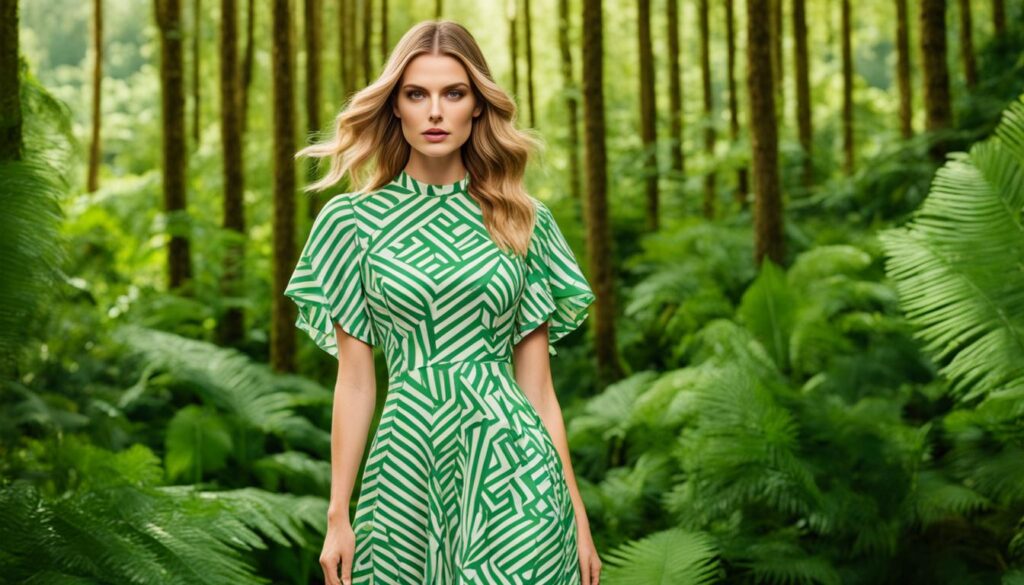As consumers become more conscious of the environmental impact of the fashion industry, sustainable fashion trends have been on the rise. From recycling plastic waste to a shift towards sustainable brands, here are some of the latest trends shaping the world of eco-friendly fashion.
Recycling Plastic Waste
One of the latest trends in sustainable fashion is the recycling of plastic waste. Traditional apparel such as swimwear, sportswear, and outerwear are often made from materials like nylon, polyester, and spandex, which have a negative impact on the environment. By manufacturing these garments from recycled plastic waste, such as water bottles, carbon emissions and waste materials can be reduced.
Recycling plastic waste not only helps to minimize the accumulation of non-biodegradable materials in landfills and oceans but also reduces the need for new plastic production. With the increasing popularity of sustainable swimwear and activewear, fashion brands are incorporating eco-friendly materials made from recycled plastic in their collections.
These innovative materials, known as eco-nylon or regenerated nylon, provide a sustainable alternative to traditional fabrics. They offer the same performance and durability without contributing to harmful environmental effects. By using recycled plastic waste, fashion brands are actively contributing to the circular economy and reducing their carbon footprint.
Benefits of Recycling Plastic Waste in Fashion
Recycling plastic waste for sustainable swimwear and other apparel comes with several benefits:
| Benefits | Description |
|---|---|
| Environmental impact | By reducing the production of new plastics, recycling plastic waste helps conserve resources and minimize pollution. |
| Carbon emissions reduction | Using recycled plastic waste reduces the carbon emissions associated with the production of traditional synthetic materials. |
| Waste reduction | Recycling plastic waste helps divert it from landfills and oceans, addressing the growing problem of plastic pollution. |
| Brand sustainability | By adopting eco-friendly materials, fashion brands enhance their sustainability credentials and appeal to conscientious consumers. |
Recycling plastic waste is a significant step towards creating a more circular and sustainable fashion industry. As more brands embrace this trend and consumers support eco-conscious alternatives, it paves the way for a greener future in fashion.
Shift to Sustainable Brands
As the demand for sustainable fashion continues to grow, consumers are shifting their focus towards sustainable brands. In today’s fashion landscape, luxury brands that prioritize sustainability are gaining popularity among conscious shoppers. These brands not only offer high-quality materials and unique fashion statements but also actively contribute to environmental conservation.
One prominent example is Ralph Lauren, a luxury fashion brand that has made significant efforts to combat climate change and protect our oceans. By signing pacts and partnering with environmental organizations, Ralph Lauren showcases a strong commitment to sustainability. Their initiatives have garnered widespread attention and praise, attracting a loyal customer base.
In addition to their commitment to sustainability, these brands also leverage the power of social media to connect with their target audience. With a strong social media presence, sustainable luxury brands effectively spread awareness about their ethical practices and engage with consumers who prioritize sustainability in their fashion choices.
By choosing to support sustainable brands, consumers play an active role in promoting environmentally responsible practices within the fashion industry. The rise of these brands signifies a positive shift towards a more sustainable and conscious fashion future.
The Benefits of Supporting Sustainable Brands
When you choose to support sustainable brands, you contribute to a greener and more ethically conscious fashion industry. Some of the key benefits of supporting these brands include:
| Benefits | Explanation |
|---|---|
| Environmental Impact | Sustainable brands prioritize eco-friendly practices, reducing their carbon footprint and promoting the conservation of natural resources. |
| High-Quality Materials | These brands use premium materials, ensuring durability and longevity of the products, reducing the need for frequent replacements. |
| Uniqueness and Individuality | Sustainable brands often offer unique and limited-edition fashion pieces, allowing you to stand out and express your personal style. |
| Social Impact | By supporting sustainable brands, you contribute to fair labor practices and support the livelihoods of workers in the fashion industry. |
Cruelty-Free and Vegan Fashion
The fashion industry has long relied on animal skins and pelts for materials like leather, fur, wool, and silk. However, as consumers become more conscious of animal cruelty and environmental impact, there has been a significant rise in the popularity of cruelty-free and vegan fashion. In the last five years, this industry has seen tremendous growth, offering a wide range of affordable, high-quality, and animal-free clothing options.

More and more shoppers are embracing the philosophy of cruelty-free fashion, which involves refraining from using animal-derived materials and instead opting for ethical alternatives. Vegan fashion, an offshoot of cruelty-free fashion, goes even further by not only rejecting animal-based materials but also excluding any products that involve harm or exploitation of animals in their production process.
The popularity of cruelty-free and vegan fashion is not limited to a niche market. Major fashion brands and designers, such as Stella McCartney, Matt & Nat, and Vaute Couture, have embraced these principles and incorporated them into their collections. This has fueled the availability and accessibility of animal-free clothing for consumers across various price ranges and styles.
With advancements in textile technology, synthetic materials such as recycled polyester, plant-based fabrics like hemp and bamboo, and innovative alternatives to leather and fur are becoming widely used in the creation of cruelty-free and vegan fashion. These materials offer comparable quality, durability, and style without the ethical concerns associated with traditional animal-based materials.
In addition to being cruelty-free and eco-friendly, vegan fashion also aligns with the values of many consumers who prioritize sustainability and ethical consumption. By choosing animal-free alternatives, individuals can express their personal style and make a positive impact on the environment and animal welfare.
Use of Data and AI
Technology is revolutionizing the world of sustainable fashion, with the use of data and artificial intelligence (AI) leading the way. Retailers are leveraging virtual fitting rooms to enhance the consumer experience and mitigate returns, while AI algorithms are predicting clothing trends, sales patterns, and consumer behavior, resulting in a significant reduction in unsold clothes each season. The integration of digitalization and technology has also contributed to a decrease in the carbon footprint of fashion brands.
Virtual Fitting Rooms: Enhancing the Consumer Experience
Virtual fitting rooms offer a convenient and immersive way for customers to try on clothes virtually before making a purchase. By utilizing 3D scanning technology and augmented reality, shoppers can visualize how garments will look and fit without physically trying them on. This not only reduces the hassle of returns and exchanges but also minimizes the environmental impact associated with shipping and packaging.
AI Trend Predictions: Staying Ahead of the Curve
Artificial intelligence has transformed the fashion industry by providing valuable insights into consumer preferences and predicting upcoming trends. AI algorithms analyze vast amounts of data, including social media trends, runway shows, and sales data, to identify emerging styles and patterns. Fashion brands can leverage these predictions to develop sustainable collections that align with current market demands, preventing overproduction and reducing waste.
Reduced Unsold Clothes: Sustainable Inventory Management
Unsold clothes have long been a challenge for the fashion industry, contributing to wastage and unsustainable practices. However, AI-powered inventory management systems have revolutionized the way brands manage their stock. By leveraging data on customer preferences, sales history, and inventory levels, fashion retailers can optimize their production, forecasting, and distribution processes, resulting in reduced unsold inventory and minimized environmental impact.
Digitalization and Sustainability: A Greener Future
The digitalization of fashion has brought forth numerous benefits for sustainability. From virtual showrooms and online shopping to digital marketing and supply chain optimization, technology has enabled fashion brands to reduce their carbon footprint. By embracing data-driven decision-making and AI-powered solutions, fashion retailers can continue to make strides towards a greener, more sustainable future.
| Benefits of Data and AI in Sustainable Fashion | Examples |
|---|---|
| Enhanced consumer experience through virtual fitting rooms | Virtual Try-On feature on the Ralph Lauren app |
| Accurate trend predictions for sustainable collections | Zara’s use of AI to analyze social media data for trend forecasting |
| Optimized inventory management to reduce waste | Patagonia’s use of AI to forecast demand and minimize overproduction |
| Decreased carbon footprint through digitalization | H&M’s shift towards digital marketing to reduce paper waste |
Transparency and Regulation
In the rapidly evolving world of sustainable fashion, market transparency and increased regulations play vital roles. With the aim of creating a more accountable and eco-conscious industry, the European Commission is taking significant steps towards implementing a digital passport for all physical goods. This initiative ensures market transparency and allows consumers to easily access essential information about the products they purchase.
By introducing a digital passport, consumers will have a clearer understanding of the sustainability practices employed in the production of their favorite fashion items. This transparency empowers individuals to make informed choices, supporting brands that align with their values and promoting a more sustainable future.
Moreover, as the demand for ethical and eco-friendly fashion continues to grow, increased regulations are expected to further drive the sustainability movement. These regulations will focus on promoting greener practices throughout the fashion supply chain, from sourcing materials to manufacturing and distribution. Additionally, efforts will be made to reduce overproduction, minimizing waste and environmental impact.

